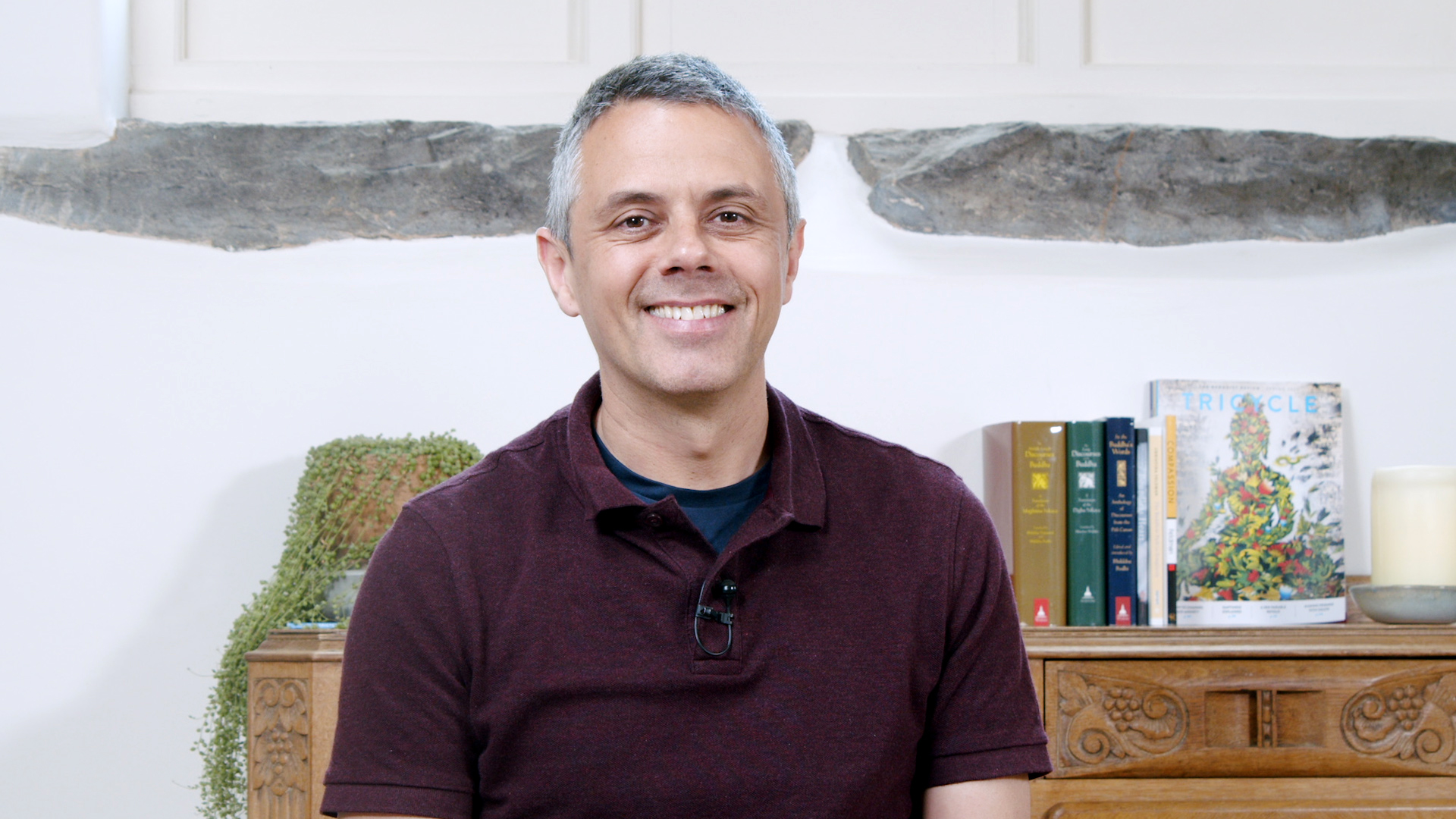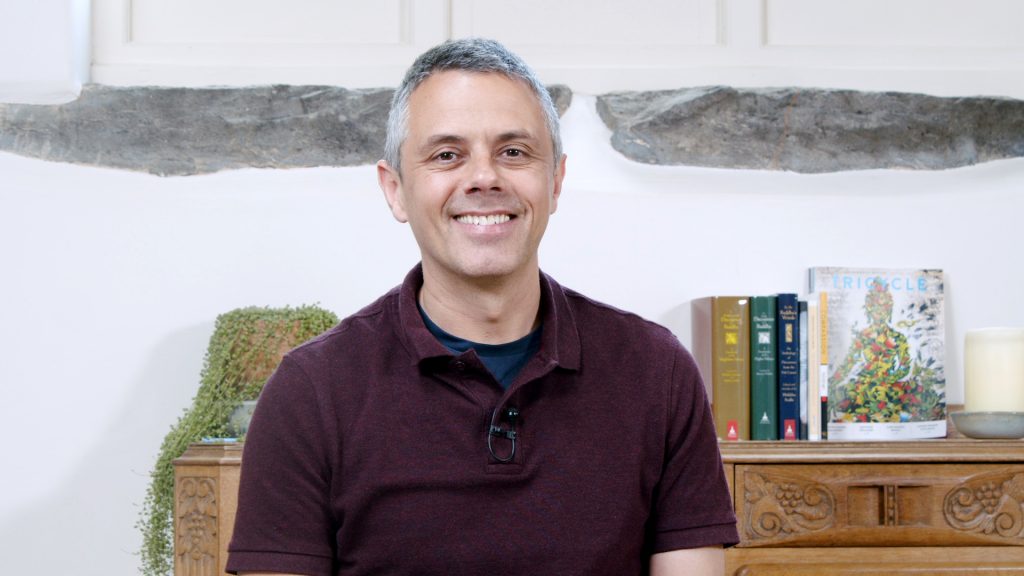Exploring the Protective Qualities of Sati
In an excerpt for our latest online course, The Five Spiritual Powers, Gaia House’s Jake Dartington reflects on the many functions of mindfulness. The post Exploring the Protective Qualities of Sati appeared first on Tricycle: The Buddhist Review.

In an excerpt for our latest online course, The Five Spiritual Powers, Gaia House’s Jake Dartington reflects on the many functions of mindfulness.
By Jake Dartington Feb 17, 2024 Jake Dartington
Jake DartingtonSati is usually translated as mindfulness. It includes a sense of awareness of thoughts, feelings, bodily sensations, and the world around us.
Some years ago, I found a story in a psychology textbook about a person who’d arranged to meet a friend for lunch at a café. Unfortunately, this friend didn’t arrive for lunch, so the person was waiting for a while—first for ten minutes, then twenty minutes, and then a half hour, getting frustrated and experiencing increasingly difficult states of mind the more time went on. In the end, the person wound up feeling very distressed about their friend not turning up.
Now, in this example, the person was so fixed and intransigent in their way of relating to what had happened that this particular event resulted in their friendship actually coming to an end. The person who tried in vain to arrange the plans wouldn’t accept any apology, wouldn’t accept any explanation, and didn’t give the other person an opportunity to make amends despite the person apologizing several times.
On the one hand, this example is very simple, but I also find it very moving, because if we were to respond to difficulty in our family life, with our friends, and in our work life in this habitual way, the consequences, the effects of that—in terms of our well-being and how we live with others—would be enormous. But if we can find ways to respond skillfully, wisely, and compassionately to these times when things go wrong and when unwanted feelings arise, the effect of that would also be significant for our lives.
So how does sati help? Sati is seen as having different dimensions to it. Sometimes people think of the dimension as simple awareness. That’s usually the first thing that comes to mind when people think of mindfulness. But in addition to this aspect of simple awareness, sati has many other roles and functions, including its role as a protective quality.
Let’s go back to that person in the café. After waiting for several minutes, they may have begun to notice that, “Gosh, my mind is getting caught in these thoughts and judgments of this person” or “They’ve let me down. This is really rude. This is disrespectful.” Or they may have even thought, “Gosh, I’m going down an increasingly unhelpful direction here.”
That protective dimension of sati is what notices those specific thought patterns and is also what helps you to attend to those types of situations in different ways. So sati wouldn’t say that we need to push away those thoughts and feelings in an automatic way, but that we can be aware of those thoughts and feelings and then maybe choose to place our attention somewhere else. That person could instead feel their feet on the ground or feel the breath in their body and be more aware of the emotions and feelings that are arising, rather than being caught in them. This protects us from the impulse to do something unskillful, like send the friend a very hostile text.
Sati also has an investigative quality. In that same situation, the person may notice what’s happening in the body and be really curious and bring a sense of investigation to what’s arising. Maybe the throat feels tight or the heart is beating more quickly, maybe the hands are gripping, or there’s a tension in the jaw. In this example, the investigative quality includes a sense of what’s happening in the body underneath the stories about how the friend is being rude or disrespectful.
This investigative quality could also include the beliefs that are present. There may be a sense of “What am I believing right now? I’m believing that this is really rude and disrespectful.” But that then becomes something that can be questioned rather than something just unconsciously believed and followed.
The protective dimension of sati, along with its investigative dimension, can both really help in such a situation, and these also support the capacity to reframe one’s perception. Another way of putting it would be that sati supports greater cognitive flexibility.
Reframing perception means we can see things in different ways and not be locked into one perspective. In that situation, the perception that might have arisen could be “This was rude. They have let me down. This is disrespectful.” But sati can help us say, “Maybe there’s another way to see this. Maybe there’s another perspective.” This is a very liberating thing to do. Maybe the person has been so busy with what they’re doing that they just forgot. Or maybe there’s been a family emergency that meant that they couldn’t come. Or maybe they’ve been so stressed and overwhelmed that this just skipped their mind. Reframing one’s perception could instead result in the plan arranger thinking: “I hope my friend is OK. Let me check with them and see what’s happened.”
Reframing perception can lead to much more flexible ways of responding rather than sending hostile text messages or being locked into unskillful ways of thinking, meaning the person can then make a different choice: to check on the friend to see what’s happening.
This relates to the final function of sati I wanted to suggest, which is around rebalancing the negativity bias in our perceptions. Many teachers remind us that—for very understandable reasons—as human beings, we’ve evolved a tendency to focus on what’s particularly threatening.
Some people take an evolutionary perspective on that: that our ancestors needed to scan the environment to look for potential threats. And of course, if we were in a situation where there were wild animals that were going to attack us, that would be very important. The person that just sat there thinking, “Oh, what a lovely day. I don’t need to worry about that rustle in the bushes…” would be in a very dangerous predicament. Scanning the environment for threats can have an adaptive function. And yet, if we’re doing that now in an automatic, habitual way, it means we can easily get very caught in threat-based perceptions. When we overly focus on that, it becomes a disruption to our overall well-being. Sati is a very skillful counterbalance to this negativity bias. What else can we notice? What else can we be aware of?
To go back to the person in the café, rather than simply fixating on the absence of their friend, they might notice something different. “Oh. I’ve got a book in my bag. I can take my book out and read that.” Or, “Maybe I can look around the restaurant and enjoy the decor. Maybe I can really look at the menu in a different way and think, ‘OK, this is not what I chose. I’m here on my own, but maybe I can really enjoy this meal in a different way.’”
So what we’re attending to and how we’re attending to it can help us to rebalance our perceptions away from an excessive focus on negative thoughts to that which is more uplifting, that which is more lovely.
This everyday example of a disappointing event at a café actually stands in for all unpleasant, unwanted, difficult things that can arise in our lives. So if that particular example doesn’t speak to you—the friend in the café—maybe try considering what’s happening in your workplaces, what’s happening with your family, what’s happening in relation to your health: all kinds of other things where a similar process and dynamic operates.
This excerpt is from Tricycle’s Online Course The Five Spiritual Powers and has been condensed and adapted for grammar and clarity.
![]()
Thank you for subscribing to Tricycle! As a nonprofit, we depend on readers like you to keep Buddhist teachings and practices widely available.
This article is only for Subscribers!
Subscribe now to read this article and get immediate access to everything else.
Already a subscriber? Log in.

 JimMin
JimMin 






























